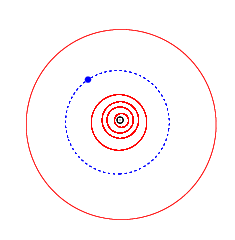9999 Wiles
|
| |||||||||||||
| Discovery | |||||||||||||
|---|---|---|---|---|---|---|---|---|---|---|---|---|---|
| Discovered by |
C. J. van Houten, I. van Houten-Groeneveld, & T. Gehrels | ||||||||||||
| Discovery date | 29 September 1973 | ||||||||||||
| Designations | |||||||||||||
| MPC designation | 9999 Wiles | ||||||||||||
Named after | Andrew Wiles | ||||||||||||
| 4196 T-2, 1995 EM8 | |||||||||||||
| main belt | |||||||||||||
| Orbital characteristics[1] | |||||||||||||
| Epoch 13 January 2016 (JD 2457400.5) | |||||||||||||
| Uncertainty parameter 0 | |||||||||||||
| Observation arc | 15250 days (41.75 yr) | ||||||||||||
| Aphelion | 3.0380315 AU (454.48304 Gm) | ||||||||||||
| Perihelion | 2.6393810 AU (394.84578 Gm) | ||||||||||||
| 2.8387062 AU (424.66440 Gm) | |||||||||||||
| Eccentricity | 0.0702169 | ||||||||||||
| 4.78 yr (1746.9 d) | |||||||||||||
| 350.2670° | |||||||||||||
| 0° 12m 21.867s / day | |||||||||||||
| Inclination | 3.199406° | ||||||||||||
| 76.37237° | |||||||||||||
| 235.08741° | |||||||||||||
| Earth MOID | 1.62468 AU (243.049 Gm) | ||||||||||||
| Jupiter MOID | 2.1303 AU (318.69 Gm) | ||||||||||||
| Jupiter Tisserand parameter | 3.304 | ||||||||||||
| Physical characteristics | |||||||||||||
| 3.4822 h (0.14509 d) | |||||||||||||
| |||||||||||||
| C-type asteroid[2] | |||||||||||||
| 12.9 | |||||||||||||
|
| |||||||||||||
9999 Wiles is a C-type asteroid from the asteroid belt. It orbits the Sun every 4.8 years.
It was discovered by C. J. van Houten, I. van Houten-Groeneveld and T. Gehrels on September 29, 1973. Given the provisional designation 4196 T-2, it was renamed 9999 Wiles in honour of Andrew J. Wiles, who proved Fermat's last theorem.[3]
References
- ↑ "9999 Wiles (4196 T-2)". JPL Small-Body Database. NASA/Jet Propulsion Laboratory. Retrieved 13 April 2016.
- ↑ Gianluca Masi; Sergio Foglia & Richard P. Binzel. "Search for Unusual Spectroscopic Candidates Among 40313 minor planets from the 3rd Release of the Sloan Digital Sky Survey Moving Object Catalog".
- ↑ MPC 34356 Minor Planet Center
External links
This article is issued from Wikipedia - version of the 9/10/2016. The text is available under the Creative Commons Attribution/Share Alike but additional terms may apply for the media files.
